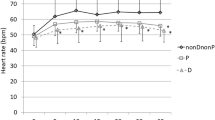Abstract
Purpose
In this study we investigated the effects of intravenously administered dexmedetomidine on the duration of hyperbaric ropivacaine in spinal anesthesia, and the side effects.
Methods
In a prospective, double-blind study, sixty ASA I-II patients were randomized to two groups of 30 individuals. All patients were administered hyperbaric ropivacaine (22.5 mg) for spinal anesthesia. Intravenous dexmedetomidine was administered in group I for 60 min, physiological saline at the same amount and duration was infused in group II.
Results
Measurements of mean blood pressure before and after the procedure revealed significant decreases in group I compared with group II after 20, 25, and 30 min. The times for two dermatomes regression of the blockade and complete resolution of motor blockade were significantly prolonged in group I. The sedation score in the dexmedetomidine group was significantly increased compared with controls. Atropine requirement was found to be significantly higher in group I than in group II.
Conclusion
Our results show that intravenously administered dexmedetomidine prolonged the duration of spinal anesthesia, provided sufficient sedation, and had few side effects. Therefore, dexmedetomidine is appropriate during spinal anesthesia, if the anesthesiologist is alert for development of bradycardia.



Similar content being viewed by others
References
Brown DL. Spinal, epidural and caudal anesthesia. In: Miller RD, editor. Anesthesia. Philadelphia: Churchill-Livingstone; 2000. p. 1492–8.
Bernard CM. Epidural and spinal anesthesia. In: Barash PG, editor. Clinical anesthesia. Philadelphia: Lippincott Williams & Wilkins; 2001. p. 645–68.
Rhee K, Kang K, Kim J, Jeon Y. Intravenous clonidine prolongs bupivacaine spinal anesthesia. Acta Anaesthesiol Scand. 2003;47:1001–5.
Kanazi GE, Aouad MT, Jabbour-Khoury SI, Al Jazzar MD, Alameddine MM, Al-Yaman R, Bulbul M, Baraka AS. Effect of low-dose dexmedetomidine or clonidine on the characteristics of bupivacaine spinal block. Acta Anaesthesiol Scand. 2006;50:222–7.
Whiteside JB, Burke D, Wildsmith JAW. Spinal anaesthesia with ropivacaine 5 mg/ml in glucose 10 mg/ml or 50 mg/ml. Br J Anaesth. 2001;86:241–4.
Whiteside JB, Burke D, Wildsmith JAW. Comparison of ropivacaine 0.5% (in glucose 5%) with bupivacaine 0.5% (in glucose 8%) for spinal anaesthesia for elective surgery. Br J Anaesth. 2003;90:304–8.
McLeod GA. Density of spinal anaesthetic solutions of bupivacaine, levobupivacaine, and ropivacaine with and without dextrose. Br J Anaesth. 2004;92:547–51.
Chung CJ, Choi SR, Yeo KH, Park HS, Lee SI, Chin YJ. Hyperbaric spinal ropivacaine for cesarean delivery: a comparison to hyperbaric bupivacaine. Anesth Analg. 2001;93:157–61.
Dawson C, Ma D, Chow A, Maze M. Dexmedetomidine enhances analgesic action of nitrous oxide: mechanisms of action. Anesthesiology. 2004;100:894–904.
Gentili M, Huu PC, Enel D, Hollande J, Bonnet F. Sedation depends on the level of sensory block induced by spinal anaesthesia. Br J Anaesth. 1998;81:970–1.
Pollock JE, Neal JM, Liu SS, Burkhead D, Polissar N. Sedation during spinal anesthesia. Anesthesiology. 2000;93:728–34.
Pouttu J, Scheinin B, Rosenberg PH, Viinamaki O, Scheinin M. Oral premedication with clonidine: effects on stress responses during general anaesthesia. Acta Anaesthesiol Scand. 1987;31:730–4.
Almeida RA, Lauretti GR, Mattos AL. Antinociceptive effect of low-dose intrathecal neostigmine combined with intrathecal morphine following gynecologic surgery. Anesthesiology. 2003;98:495–8.
Maze M, Tranquilli W. Alpha-2 adrenoceptor agonists: defining the role in clinical anesthesia. Anesthesiology. 1991;74:581–605.
Mikawa K, Nishina K, Maekawa N, Obara H. Oral clonidine premedication reduces postoperative pain in children. Anesth Analg. 1996;82:225–30.
Weinbroum AA, Ben-Abraham R. Dextromethorphan and dexmedetomidine: new agents for the control of perioperative pain. Eur J Surg. 2001;167:563–9.
Choyce A, Peng P. A systematic review of adjuncts for intravenous regional anesthesia for surgical procedures. Can J Anaesth. 2002;49:32–45.
Memis D, Turan A, Karamanlioglu B, Pamukçu Z, Kurt I. Adding dexmedetomidine to lidocaine for intravenous regional anesthesia. Anesth Analg. 2004;98:835–40.
Jaakola ML. Dexmedetomidine premedication before intravenous regional anesthesia in minor outpatient hand surgery. J Clin Anesth. 1994;6:204–11.
Lurie SD, Reuben SS, Gibson CS, DeLuca PA, Maciolek HA. Effect of clonidine on upper extremity tourniquet pain in healthy volunteers. Reg Anesth Pain Med. 2000;25:502–5.
Kristensen JD, Karlsten R, Gordh T. Spinal cord blood flow after intrathecal injection of ropivacaine: a screening for neurotoxic effects. Anesth Analg. 1996;82:636–40.
Kallio A, Scheinin M, Koulu M, Ponkilainen R, Ruskoaho H, Viinamäki O, Scheinin H. Effects of dexmedetomidine, a selective α-2-adrenoceptor agonist, on hemodynamic control mechanisms. Clin Pharmacol Ther. 1989;46:33–42.
Bloor BC, Ward DS, Belleville JP, Maze M. Effects of intravenous dexmedetomidine in humans. II. Hemodynamic changes. Anesthesiology. 1992;77:1134–42.
Mantz J. Dexmedetomidine. Drugs Today (Barc). 1999;35:151–7.
Carpenter RL, Caplan RA, Brown DL, Stephenson C, Wu R. Incidence and risk factors for side effects of spinal anesthesia. Anesthesiology. 1992;76:906–16.
Katı İ, Demirel CB, Abbasov ÜH, Silay E, Coşkuner İ, Tomak Y. İğne Tipinin Spinal Anestezi Komplikasyonları Üzerine Etkileri. Van Tıp Dergisi. 2002;9:20–4.
Tarkkila PJ, Heine H, Tervo RR. Comparison of Sprotte and Quincke needles with respect to post dural puncture headache and backache. Reg Anesth. 1992;17:283–7.
Vassilieff N, Rosencher N, Sessler DI, Conseiller C. Shivering threshold during spinal anesthesia is reduced in elderly patients. Anesthesiology. 1995;83:1162–6.
Sessler DI. Perianesthetic thermoregulation and heat balance in humans. FASEB J. 1993;7:638–44.
Acknowledgments
We would like to thank Dr. I. Coskuner and Dr. C. Yagmur for their assistance.
Author information
Authors and Affiliations
Corresponding author
About this article
Cite this article
Elcıcek, K., Tekın, M. & Katı, I. The effects of intravenous dexmedetomidine on spinal hyperbaric ropivacaine anesthesia. J Anesth 24, 544–548 (2010). https://doi.org/10.1007/s00540-010-0939-9
Received:
Accepted:
Published:
Issue Date:
DOI: https://doi.org/10.1007/s00540-010-0939-9




